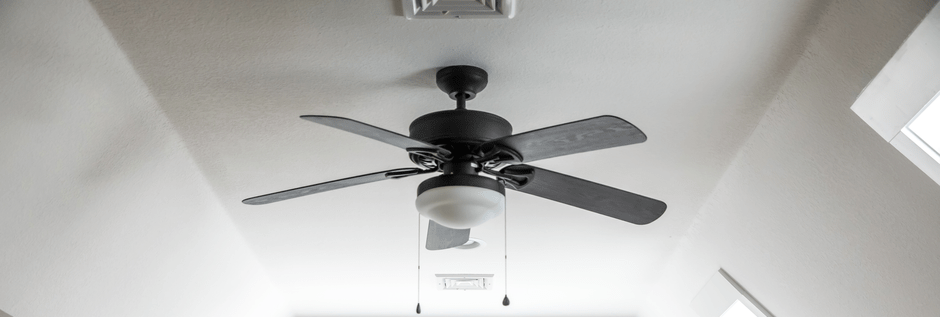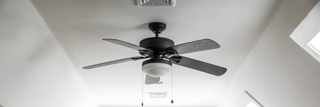What’s the right ceiling fan direction for winter and summer?
Save on energy costs by making sure your ceiling fan direction is correct.

Key tips to remember
- Ceiling fans should spin counterclockwise in summer for the downdraft
- Ceiling fans should spin clockwise in winter to create an updraft
- The right ceiling fan direction saves wear and tear on your HVAC
- When ceiling fans spin in the correct direction, your home is more efficient
- When your home is more efficient, you save money on utility bills
Which way should a fan spin? If you’ve never thought to ask this question or how to change a ceiling fan’s direction, this is nothing to be embarrassed about. Plenty of homeowners are surprised to learn that fan blade direction makes a real difference, depending on the time of year. Many aren’t even aware that ceiling fans spin in two different directions. No big deal. It’s easy not to register on your radar. Still, it’s better to learn the best way to cool a room (or heat it) sooner rather than later because the right fan direction has real potential to increase your comfort throughout your home and help you save money on your utility bills while decreasing the wear and tear on your HVAC unit.
Why use a ceiling fan anyway?
There are many good reasons for using a ceiling fan, but let’s begin with the basics. First, it simply feels good to have some air moving on your skin. Nobody likes to be cooped up in a house full of stagnant, stale air. Opening your windows on beautiful days, no matter the season, and letting your fans circulate the fresh air throughout your home is a refreshing feeling. It also helps banish lingering odors from cooking, pets, home improvement projects like painting, and let’s face it…bathrooms!
More ceiling fan benefits
In addition to all these benefits, ceiling fans are also great pinch-hitters for overworked HVAC systems, giving them a bit of a break when they’re working their hardest, especially in peak seasons of the year when temperatures are at extremes. In turn, your system lasts longer as your heating and cooling bills shrink up to 40%. While we’re at it, let’s not forget the benefits of outdoor ceiling fans installed in covered porches or other open-air areas of your home. When added to an outdoor gathering spot, a ceiling fan can help you stay cooler and more comfortable while keeping away any pesky flies or mosquitoes buzzing around your mojito.
Fan direction in summer: counterclockwise
Which way should the ceiling fan turn in the summer? The answer is counterclockwise. Set it at the highest speed to create a column of air that feels cold, even if it’s not actually cold, which your fan pushes downward, allowing you to set your HVAC system a few degrees warmer than you would otherwise. That wind-chill effect you feel is the moving air evaporating the perspiration on your skin, making you feel cooler. You want to be sure that the cool being pushed down is used to cool the people in your home as efficiently as possible before it dissipates. This cool breeze on your skin in the summertime can make the room feel considerably cooler than it is, helping you reduce the use of your HVAC unit and saving you up to 40% on energy costs. It also allows you to be more comfortable indoors for longer. This year, let your summer fan rotation go counterclockwise and you’ll be on the right track. Remember, if you’re standing under the fan and don’t feel the breeze, your fan is spinning in the wrong direction for that coveted summertime cooling effect.
Fan direction in winter: clockwise
When it comes to ceiling fan settings for winter, you need to do the opposite from the summer, meaning your fan should rotate clockwise to create an updraft, helping to redistribute a column of already warmed air upward and throughout your home. Redistributing that warmed air can make everyone feel more comfortable in the colder months while reducing the demand on your HVAC system. This can save you up to 15% on related heating expenditures and help you eliminate the need for supplemental systems like space heaters, electric blankets and other items that can add to cluttering your home.
When it’s really cold outside, it may seem counterintuitive to turn on the ceiling fans. But if you set them at the lowest speed and run them clockwise, they’ll push a column of cooler air up toward the ceiling, where the warm air your HVAC unit has already heated congregates. This updraft of cooler air displaces the lingering warm air, sending it cascading toward the walls and floors, effectively distributing the warmer air more widely around the room. You’ll feel warmer, and you’ll be able to set your thermostat at a cooler temperature as a result, giving your HVAC system a bit of a break.
Exceptions to the rule
One exception to all these rules is when you mount a ceiling fan very high on a vaulted or cathedral ceiling. In this case, the fan may be too far from the floor to create the wind-chill factor you’re after, so it’s OK to leave this fan in the counterclockwise position year-round. Another exception is for dining rooms because you might not want to cool off your food as fast as possible. In this case, choose a lower speed for your fan and you’ll retain the benefits of the circulating air without cooling off the main course before everyone has a chance to sit down.
If you smoke inside the house, always have clean ashtrays and charged fire extinguishers handy. Be sure to set your ceiling fans to run clockwise to pull the smoke up and away. You may also want to open windows and turn on your HVAC fan to help circulate the smoke toward the outdoors.
The right fan for the room
Before you decide to purchase or replace your ceiling fans, verify you’re getting the right size of fan for the room. If you’re tempted to get the biggest fan you can find, you might be surprised that it moves too much air, and you’ll end up growing tired of chasing papers and other lightweight items around the room. Then again, if you’re tempted to save money on a fan that’s too small, you’re not going to feel the effects you’re after. Find fans rated for the square footage of the room you have in mind.
Making the change
Changing the direction of a ceiling fan is usually pretty simple. Make sure the blades have come to a complete stop, then find the switch on the motor housing. If your fan lacks a switch, it might have a button on a remote, or even works through a mobile app or voice commands if your fan is newer and “smarter” than average. While you’re at it, don’t forget to adjust your thermostat accordingly to realize the financial benefits of using the fans in the first place. When you plan your installation, install your ceiling fans somewhere between 7 and 9 feet from the floor, and a minimum of 10 inches from the ceiling for proper blade clearance. If your room has vaulted ceilings, consider a rod that lowers the fan to the precise height you prefer.
Remembering
Remembering exactly when to change the direction your ceiling fans spin is as simple as keeping track of the seasons. Better yet, consider aligning that switch in your mind with daylight saving time. When you spring forward and set your clocks ahead, set your fans to spin counterclockwise. When you fall back and set the clocks backward an hour, go ahead and set your ceiling fans to spin clockwise for the winter.
Another thing to remember is to turn off the fan when people leave a room. Hopefully, you’re already in the habit of turning off lights when rooms are empty. Realizing energy savings hinges on not wasting electricity when you don’t need it. It’s also important to remember to buy an outdoor-rated ceiling fan for porches and outdoor situations because they’re designed to withstand weather and temperature changes better than typical indoor models.
We hope you’ve enjoyed our post on ceiling fan direction and that it’s given you some useful ideas to help save you some money and keep you comfortable all year. While you’re here, you might also want to check out our fall home maintenance checklist, or read how to turn your house into an energy efficient home by cutting energy costs with our green home tips. These are only a few of our many free and helpful home improvement articles. Thanks for stopping by!
The information in this article is intended to provide guidance on the proper maintenance and care of systems and appliances in the home. Not all of the topics mentioned are covered by our home warranty or maintenance plans. Please review your home warranty contract carefully to understand your coverage.
